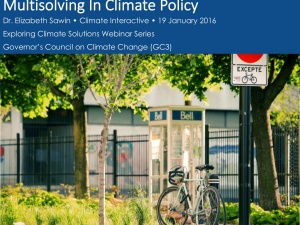Ten Strategies For Capturing Multiple Benefits in Climate Action Plans
By
Elizabeth Sawin
February 1, 2016
 Hundreds of cities, states, nations, and businesses made pledges in Paris to reduce greenhouse gas emissions. These ten strategies could help make sure that the process of meeting climate goals provides benefits in health, justice, jobs and resilience.
Hundreds of cities, states, nations, and businesses made pledges in Paris to reduce greenhouse gas emissions. These ten strategies could help make sure that the process of meeting climate goals provides benefits in health, justice, jobs and resilience.
Recently, I spoke in a webinar series convened in support of the state of Connecticut’s 2050 climate action planning process. Watch the recording of the webinar here. Or, read on for a digest of ten multisolving strategies I shared in the webinar:
- **Broaden the circle of decision makers. **To find multiple benefits, you need multiple perspectives. Don’t try to make climate policy as a group of climate and energy experts. Bring in social scientists, public health officials, economic development officers, and community members. Take the time to learn each other’s language. Cultivate curiosity about the blind spots of each discipline.
- **Reframe success as optimizing for many variables rather than maximizing one. **If you can double health benefits by sacrificing a percentage point on carbon reductions, celebrate the win for the whole system.
- **Find out what co-benefits matter to people. **Don’t assume you know which co-benefits matter the most. Instead, reach out until you understand the non-climate benefits that matter to people. Try to understand the biggest obstacles facing hospitals (or the train system, or families, or farmers, etc) and then see if you can envision a way to address that problem that also reduces emissions.
- **Don’t just focus on the benefits; focus also on their distribution. **Addressing climate change could provide a way to create more equal societies, but achieving this takes intention, planning, and policy focused on justice, equity, and fairness.
- **Don’t be limited by existing analytic tools. **Most analytic tools for emissions reduction planning offer a menu of investment and policy options. This can be very helpful and you should learn as much as you can from such approaches. However, don’t forget that, from shorter work weeks to reducing consumption to forming community gardens, there may be emissions-reducing approaches that will work in your community that have not yet been incorporated into numerical analysis. Don’t let that limit your explorations.
- **Recognize that not everything that matters can be measured **How much is it worth that a grandmother on a fixed income doesn’t have to choose between food and heat? How much is it worth that hundreds more kids can run around at recess without an inhaler? Try to supplement your numerical analysis with stories of multiple benefits. Once you can picture the stories you’d like to be able to tell about the multiple benefits of your climate strategy, look again at the policy provisions in the strategy and make sure you’ve built in provisions that are likely to deliver that benefit.
- Remember that multiple benefits don’t happen by accident. Create a checklist to be sure there are policy elements focused on each benefit you’d like to capture. For example, if you think renewable energy will bring jobs, consider what provisions are needed to make sure they are good jobs for local people. If you think renewable energy might build resilience to extreme events, figure out how to incentivize electricity storage or independence from the electricity grid.
- Eradicate jurisdictional silos. One of the biggest barriers to multisolving arises when investments come from one department or budget (say energy or transportation) and benefits accrue to another (say health). Recognize that you may need to work together across divisions to get the incentives right so that all players get the credit they need for the good they can do together for the whole system.
- Be prepared to share power and resources with more local levels. Sometimes the synergies between multiple goals can most easily be found at the local level and may be very different from place to another. Capturing these opportunities may require passing decision making authority or financial support or both down to more local levels.
- **Track your progress toward multiple benefits as carefully as you track your emissions reduction progress. **In the decades-long effort to ‘bend the curve’ on greenhouse gas emissions, the pay-off of co-benefits may well be what drives continued progress, so make sure to devote time and resources to tracking your progress on multiple benefits.
Download the webinar slides here (pdf).
Read or share this article in pdf form.
Stay in the loop on the multiple benefits of climate action:
[contact-form-7 id=“14120” title=“Sign Up for Multisolving Updates”]
![]()

 Hundreds of cities, states, nations, and businesses made pledges in Paris to reduce greenhouse gas emissions. These ten strategies could help make sure that the process of meeting climate goals provides benefits in health, justice, jobs and resilience.
Hundreds of cities, states, nations, and businesses made pledges in Paris to reduce greenhouse gas emissions. These ten strategies could help make sure that the process of meeting climate goals provides benefits in health, justice, jobs and resilience.